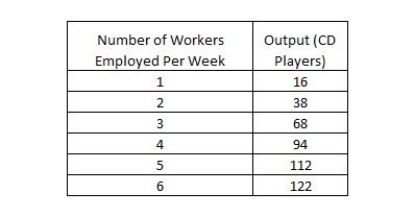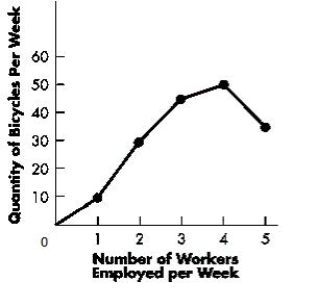A) fifth
B) seventh
C) eighth
D) ninth
E) fourth
Correct Answer

verified
Correct Answer
verified
Multiple Choice
The figure below shows the cost curves faced by an industry. Based on the figure, B represents _____.Figure 6-3 
A) the total fixed cost curve
B) the marginal cost curve
C) the average fixed cost curve
D) the average fixed cost curve.
E) the average variable cost curve
Correct Answer

verified
Correct Answer
verified
Multiple Choice
The long run:
A) is a period long enough for every input except plant size to be varied.
B) is a period in which there are no fixed costs.
C) is typically a period of two years
D) is fixed for all firms across all industries.
E) is a period in which output cannot be varied.
Correct Answer

verified
Correct Answer
verified
Multiple Choice
Lintell Inc. earned a total revenue of $10 million for the financial year 2013-14. The company incurred a total cost of $6.9 million. Lintell Inc. earned a profit of:
A) $3.1 million
B) $3.9 million.
C) $4.5 million.
D) $6 million.
E) $5.3 million.
Correct Answer

verified
Correct Answer
verified
True/False
Scarlett recently began running her husband's lumber mill. Last month, the mill made a revenue of $5,000 and paid $3,400 in out-of-pocket costs. The lumber mill made an economic profit of $1,600 last month.
Correct Answer

verified
Correct Answer
verified
Multiple Choice
When a firm makes zero economic profit, it means that:
A) When a firm makes zero economic profit, it means that:
B) the firm is covering the total opportunity costs of its resources.
C) the firm is covering its entire explicit costs but not its explicit costs.
D) the firm is not covering its opportunity costs and therefore is running at a loss.
E) the firm's social marginal benefit is greater than its social marginal cost.
Correct Answer

verified
Correct Answer
verified
Multiple Choice
When economies of scale exist, an increase in the level of output will lead to:
A) a decrease in cost per unit
B) an increase in cost per unit.
C) a decrease in total cost.
D) a decrease in profit per unit.
E) a decrease in total revenue.
Correct Answer

verified
Correct Answer
verified
Multiple Choice
If Randy's fixed cost totals $800 and the variable cost per unit is $10 for 100 units, his average total cost equals _____.
A) $8.10
B) $18.00
C) $90.00
D) $91.00
E) $81.00
Correct Answer

verified
Correct Answer
verified
Multiple Choice
When economic profits in an industry are zero and implicit costs are positive, _____.
A) accounting profits will be greater than zero
B) the firm will be running at a loss
C) accounting profits will be negative
D) the firm's revenue will not be enough to compensate for its losses, and it will to go out of business
E) accounting profits will be equal to economic profits
Correct Answer

verified
Correct Answer
verified
Multiple Choice
The change in total cost resulting from a one-unit increase in production is called:
A) total fixed cost
B) average variable cost.
C) marginal cost.
D) external cost.
E) social cost.
Correct Answer

verified
Correct Answer
verified
Multiple Choice
The table below shows how a factory's output varies with the number of workers employed each week. Based on the table, the marginal product of the fifth worker hired is:Table 6-3 
A) 112 units of output
B) 94 units of output.
C) 20 units of output.
D) 18 units of output.
E) 30 units of output.
Correct Answer

verified
Correct Answer
verified
Multiple Choice
An implicit cost is:
A) an opportunity cost to a firm.
B) an out-of-pocket expense for a firm.
C) always included by an accountant while calculating profits
D) a cost that does not affect future business decisions.
E) always larger than explicit costs.
Correct Answer

verified
Correct Answer
verified
Multiple Choice
The per-unit cost of total output is known as _____.
A) average total cost
B) external cost
C) social marginal cost
D) total fixed cost
E) private marginal cost
Correct Answer

verified
Correct Answer
verified
True/False
When long-run average total cost does not change as output varies, firms experience constant returns to scale.
Correct Answer

verified
Correct Answer
verified
Multiple Choice
Economic profits are calculated after taking into account:
A) explicit costs but not implicit costs.
B) implicit costs but not explicit costs.
C) both implicit and explicit costs.
D) only sunk costs.
E) only external costs.
Correct Answer

verified
Correct Answer
verified
Multiple Choice
A difference between the long run and the short run is that:
A) a firm is unable to vary some of its factors of production in the short run, while all the factors of production are variable in the long run.
B) a firm is able to expand output by utilizing additional workers, raw materials, and physical capital in the short run, while it is impossible to hire additional workers or add raw materials to expand output in the long run.
C) the short run is generally a period of one year, while the long run is a fixed period of 5 years for all firms across industries.
D) the short run is of sufficient length to allow a firm to transform economic losses into economic profits, while the long run is too short to turn economic losses into economic profits.
E) sunk costs are incurred in the short run, while they are not incurred in the long run.
Correct Answer

verified
Correct Answer
verified
Multiple Choice
The figure below shows how the quantity of bicycles produced per week varies with the number of workers employed per week. Based on the figure, marginal product diminishes when the _____ is hiredFigure 6-1 
A) first worker
B) second worker
C) third worker
D) fourth worker
E) fifth worker
Correct Answer

verified
Correct Answer
verified
True/False
An economic profit of zero indicates a satisfactory situation for a firm.
Correct Answer

verified
Correct Answer
verified
Multiple Choice
An example of an implicit cost of production is:
A) the cost of leather used in manufacturing furniture.
B) the cost of space in someone's home that is used as his or her home office
C) the wage paid to a high school student who works in a fast-food restaurant
D) the cost of milk bought by household consumers
E) the wage of a high school teacher who provides tuitions to his students after school hours.
Correct Answer

verified
Correct Answer
verified
Multiple Choice
David was taken to a concert by his friend who promised it would be very good. David paid for his own ticket. However, David did not like the concert and left before it ended. Therefore, David incurred a(n) _____ in buying the ticket
A) private cost
B) explicit cost
C) explicit cost.
D) implicit cost
E) sunk cost
Correct Answer

verified
Correct Answer
verified
Showing 21 - 40 of 99
Related Exams